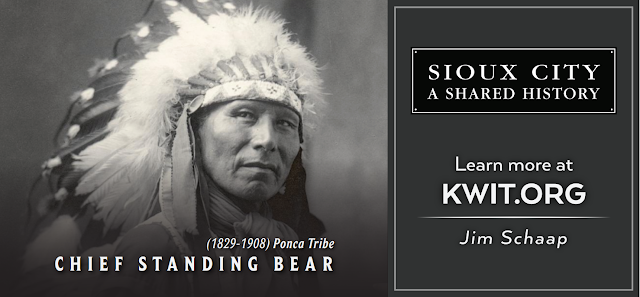[Would you care to see it, this statue of the Ponca chief Standing Bear is on display in the nation's Capitol, where it stands among a host of other notables. Standing Bear was a civil rights advocate long before he or anyone else knew what exactly that meant. Through his intense commitment to the land of his forefathers, he was able to exact American citizenship for himself and his people at a time when Indians were thought to be wards of the state, what they had been since the first white man came to the continent.
The story of Standing Bear belongs in a category with story of Rosa Parks. It is a great American story.
I'm telling it in four segments. You can listen to this first chapter here:
https://www.kwit.org/post/story-standing-bear-part-1 .
KWIT, in Sioux City, is telling the story in conjunction with the Avery Brothers, who have used their billboards to draw attention to the Native American history of the region.]
That argument was, for the Ponca, not total garbage. The Poncas were warriors, but they were few in number when compared to the Brule Sioux. What’s more, their culture was not as nomadic. They’d put down roots on the Niobrara River, literally and figuratively, planted crops long before white men determined agriculture was what they wanted all Native people to do.
The Poncas had no desire to leave home, but escaping suffering was nothing to sneeze at, so they cut a deal. It was January, 1872. Supplies were scarce, as was food, so they told this stranger that they’d agree to his demands if, first, ten Ponca chiefs could go south to see if it was a place they could abide.
If it was a good land, they might agree, but only if they could visit Washington themselves to talk with the Great Father about a move they didn’t want to make.
What those 10 chiefs found in Indian Territory was ground impossible to farm, and residents who seemed to live without hope. “We did not wish to sink as low as they seemed to be,” Standing Bear, one of the ten chiefs said. We’re not moving.
That’s when they were told they had no choice.
In a hotel room in a border town in Kansas, Standing Bear decided they were leaving Indian Territory, bound for home, directionless. “Let us go anyway,” he told the others. That night, eight chiefs left the two others, both sick, and walked on railroad tracks north, confident of somehow finding their way back to the Niobrara, two entire states away.
Eighteen days later they reached the Nebraska border, feet so bloody they left footprints on the floor of the Otoe tribal agent. Their suffering had been immense. It was late March before they reached the Omahas, their relatives and friends.
On March 30, 1872, Chief Standing Bear stood in the offices of the Sioux City Daily Journal and handed the editor a letter recounting their suffering and their unjust fate. The editor published that long letter the next day and told his readers that the Ponca’s story demanded attention from “any persons in this country who believe that every human being, however humble, is entitled to the same justice claimed for themselves.”
Other neighbors wrote letters directly to the President, protesting the Ponca’s treatment and the demand that they remove themselves from their traditional home and move to Indian Territory, a place that looked nothing like the earth where their ancestors lay. That letter recounted the Poncas’s painful, 500-mile journey across rivers and streams in March. We “have been thirty days getting back as far as the Omahas, hungry, tired, shoeless, footsore, and sad at heart. Please answer at once, for we are in trouble,” their letter to the President said.
The answer they received was waiting for them when they returned to the Niobrara. That man had asked his Washington superiors himself. “Removal of the Poncas will be insisted upon,” he was told.
Soon, painfully, those eight chiefs and 500 Ponca were told in no uncertain terms that the question of whether they would live in Indian Territory had been determined. All of them, young and old, every Ponca in the villages along the Niobrara River—they all had to leave for Indian Territory. Those chiefs had already suffered their own “trail of tears,” but there would be yet another, this one much worse, much harder, much bigger, and far more heart-rending.


No comments:
Post a Comment